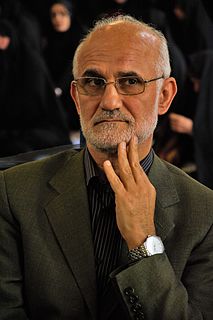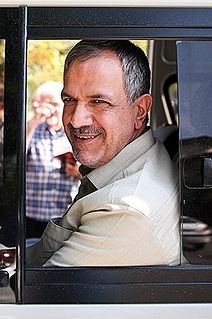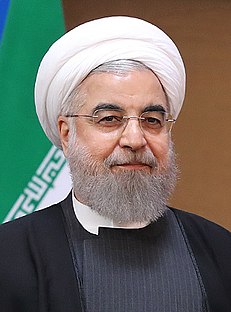 | |
| Campaigned for | Iranian presidential election, 2013 |
|---|---|
| Candidate | Akbar Hashemi Rafsanjani Chairman of the Assembly of Experts 2007-2011 President of Iran 1989-1997 Chairman of the Parliament 1980-1989 Minister of Interior 1979-1980 |
| Affiliation | Executives of Construction Party (Reformism) |
| Headquarters | Tehran, Iran |
| Key people | Eshagh Jahangiri (Manager) Ali Abdolalizadeh (Vice-manager) Majid Ansari Ali Younesi Ali Rabiee Abbas Akhoundi Mohammad Reza Sadegh Safdar Hosseini Mohammad Ali Najafi Hossein Mahjoub |
| Website | www |
| Wikinews has related news: Akbar Hashemi Rafsanjani |
Akbar Hashemi Rafsanjani (Persian : اکبر هاشمی رفسنجانی, Akbar Hāshemī Rafsanjānī, Hashemi Bahramaniهاشمی بهرمانی) served as the fourth president of Iran from 1989 until 1997.

Persian, also known by its endonym Farsi, is one of the Western Iranian languages within the Indo-Iranian branch of the Indo-European language family. It is primarily spoken in Iran, Afghanistan, and Tajikistan, Uzbekistan and some other regions which historically were Persianate societies and considered part of Greater Iran. It is written right to left in the Persian alphabet, a modified variant of the Arabic script.

The President of Iran is the head of government of the Islamic Republic of Iran. The President is the highest ranking official of Iran. The President carries out the decrees, and answers to the Supreme Leader of Iran, who functions as the country's head of state. Unlike the executive in other countries, the President of Iran does not have full control over anything, as these are ultimately under the control of the Supreme Leader. Chapter IX of the Constitution of the Islamic Republic of Iran sets forth the qualifications for presidential candidates. The procedures for presidential election and all other elections in Iran are outlined by the Supreme Leader. The President functions as the executive of the decrees and wishes of the Supreme Leader. These include signing treaties and other agreements with foreign countries and international organizations, with Supreme Leader's approval; administering national planning, budget, and state employment affairs, as decreed by the Supreme Leader. The President also appoints the ministers, subject to the approval of Parliament, and the Supreme Leader who can dismiss or reinstate any of the ministers at any time, regardless of the president or parliament's decision. The Supreme Leader Ali Khamenei directly chooses the ministries of Defense, Intelligence and Foreign Affairs, as well as certain other ministries, such as the Science Ministry. Iran’s regional policy is directly controlled by the office of the Supreme Leader with the Ministry of Foreign Affairs’ task limited to protocol and ceremonial occasions. All of Iran’s ambassadors to Arab countries, for example, are chosen by the Quds Corps, which directly reports to the Supreme Leader.
Contents
On 11 May 2013 he entered the race for the June 2013 presidential election. [1] "I came to serve. It is the right of the people to choose me or not," Iranian media quoted him as saying as he registered. [2] Rafsanjani signalled few days before registration that he would not run without Khamenei's consent. It was unclear on Saturday whether the supreme leader had in fact intervened in the final hours before registration drew to a close. [3] As early consequences merchants cut prices as the slumping Iranian currency clawed back about 4 percent against the U.S. dollar. [4]
A few days after his registration, a group of hardline Iranian lawmakers, about 100 out of 290 parliamentarians, has urged the country’s constitutional watchdog to disqualify Hashemi Rafsanjani and Esfandiar Rahim Mashaei. [5]
On 21 May Hashemi Rafsanjani was barred from standing for president by the Guardian Council. [6]


















